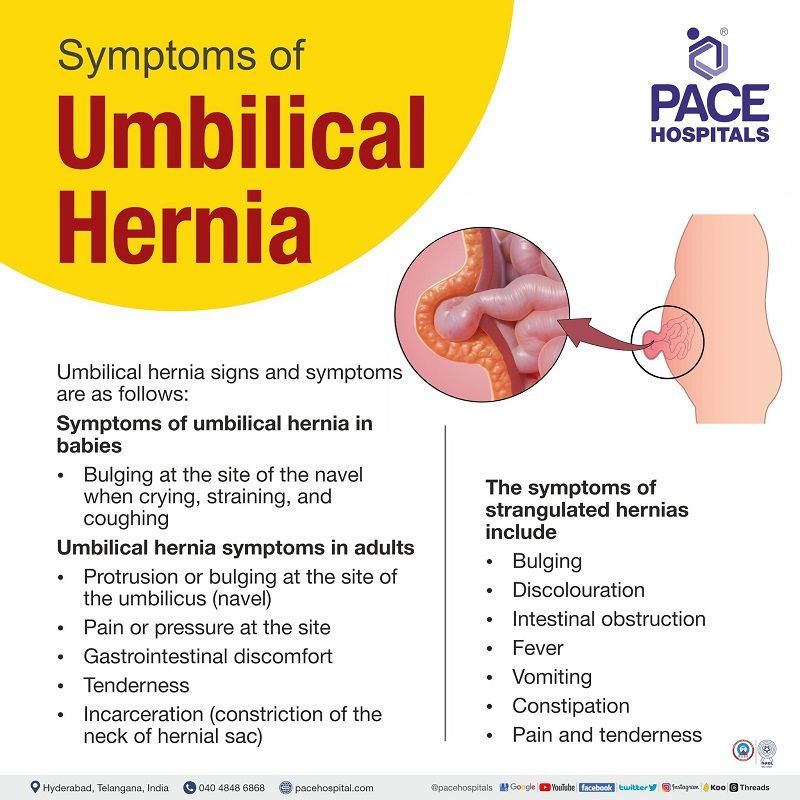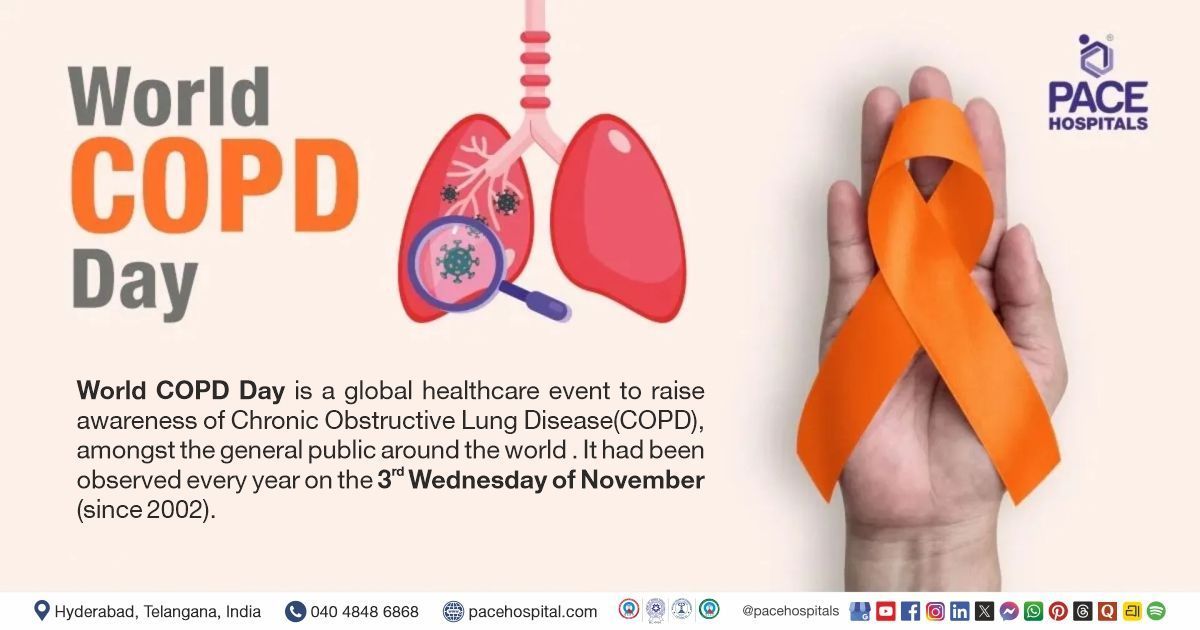Umbilical hernia - Symptoms, Causes, Complications and Prevention
Pace Hospitals
Umbilical hernia definition
A ventral hernia that is present at or close to the umbilicus (navel) is known as an umbilical hernia. An umbilical hernia occurs when fat, tissue, or an organ, typically a portion of the intestine, pushes or bumps through a weak spot in the abdominal wall near to the belly button.
Usually, an umbilical hernia develops when the layers of the abdominal wall do not fuse at the time of birth ; umbilical hernias aren’t serious and typically don't cause any major health problems.
Umbilical hernia meaning
The umbilical cord is a channel that connects a mother and the foetus and allows oxygen and nutrients from the mother to the foetus while the baby is in the mother’s womb. Usually, the baby’s umbilical cords pass through the small opening that is present in between the abdominal muscles. In most cases, this opening will be closed soon after the birth.
Still, in some cases, these abdominal wall layers don't fuse or joint completely, resulting in hernia formation. Hence, it is referred to as an umbilical hernia. According to the European Hernia Society classification, the location of the umbilical hernia is from 3 cm above (supra umbilical hernia) to 3 cm below the navel region (umbilicus).

Incidence of umbilical hernia
Umbilical hernias are the second most common type of hernia in adults, and are particularly the most common type in newborns and babies.
Umbilical hernias affect 20% of newborns, and 90% of them will naturally close or heal by the time the child is five years old. According to the American College of Surgeons, umbilical hernias account for about 10% of adult hernias. Adults experience these hernias at the age of 60 years or older.
Umbilical hernias are commonly seen in 2% of the adult population, but they may occur more frequently in obese multiparous women and cirrhotic individuals. Umbilical hernia can occur in up to 20% of cirrhotic patients with ascites. With a 3:1 ratio, umbilical hernia in women are more seemingly to have it. Incarcerated umbilical hernias are most commonly seen in males, whereas asymptomatic reducible umbilical hernias are seen in females.

Umbilical hernia symptoms
Umbilical hernia signs and symptoms are as follows:
Symptoms of umbilical hernia in babies: Umbilical hernia baby experience bulging at the site of the navel when crying, straining and coughing.
Umbilical hernia symptoms in adults
- Protrusion or bulging at the site of the umbilicus (navel).
- Pain or pressure at the site
- Gastrointestinal discomfort
- Tenderness
- Incarceration (constriction of the neck of hernial sac).
Some hernias might lead to strangulation (cessation of blood supply to the tissue or organ that has bulged out through the navel). The symptoms of strangulated hernias include:
- Bulging
- Discolouration
- Intestinal obstruction
- Fever
- Vomiting
- Constipation
- Pain and tenderness
Umbilical hernia emergency symptoms
An umbilical hernia emergency is referred to as an emergency condition that needs immediate treatment. In most cases, umbilical hernias are not serious; whenever the blood supply to the tissue cuts off, it leads to strangulation (strangulated hernia).
Symptoms of this strangulated umbilical hernia include:
- Discoloured bulge
- Fever
- Vomiting
- Tenderness and pain at the affected site

Umbilical hernia causes
The causes of umbilical hernias are as follows:
- Incomplete closure of abdominal walls at birth (in babies)
- Having multiple pregnancies
- Overweight
- Prolonged or chronic constipation that increases abdominal pressure
- A chronic or persistent cough that increases abdominal pressure
- Enlarged prostate gland, which leads to difficulty in urinating (in males)
- Ascites (excessive belly fluid)
- Straining on lifting or pushing heavy objects

Risk factors of umbilical hernia
Risk factors for umbilical hernia include:
- Pregnancy (frequent or multiple): Women are more likely to develop umbilical hernias than men. Pregnancies may cause the umbilical hernia by raising the intra-abdominal pressure progressively.
- Obesity: Patients with overweight have an increased risk of umbilical hernia, as being overweight increases abdominal pressure.
- Liver cirrhosis with ascites (fluid accumulation in the belly region): Nearly 20% of patients suffering from liver cirrhosis associated with ascites might have the risk of developing an umbilical hernia due to the increased abdominal pressure, which is primarily caused by elevated abdominal fluid accumulation.
- Chronic abdominal distension: Abdominal distension, which is caused due to intestinal obstruction, might have the risk of developing a hernia.
- History of abdominal surgeries
- Long-term peritoneal dialysis: Peritoneal dialysis leads to an abdominal wall hernia, which is the common mechanical complication of peritoneal dialysis.
- Long-term health conditions (cough, constipation, vomiting and benign prostatic hyperplasia) : These conditions increase the strain on the abdominal wall muscles and lead to hernia.
Umbilical hernia complications
The complications of umbilical hernia include:
- Strangulation: The blood flow to a strangulated hernia has been interrupted. As a result, the tissue may become inflamed, infected and eventually die (tissue necrosis). Strangulation is a medical emergency and requires immediate medical or surgical treatment.
- Incarceration: Occurs when the hernia's protrusion (and its contents) become lodged in a weak spot of the abdominal wall. It may result in bowel obstruction, accompanied by excruciating pain, nausea, vomiting, and the inability to urinate.
- Infections: Inadequate blood supply to the abdominal wall might lead to severe pain and infections.

Umbilical hernia diagnosis
The diagnosis of umbilical hernia includes various approaches, such as:
- Thorough history taking (family, medical or medication histories) of an individual
- Physical examination
- Blood tests for infections
- Barium X-ray
- Ultrasonography (USG)
- Computed tomography (CT scan)
- Magnetic resonance imaging (MRI scan)
Umbilical hernia treatment
Treatment for umbilical hernias includes various approaches, such as:
- Lifestyle modifications
- Wait and watch approach
- Surgical approaches
- Suture repair
- Mesh repair
Suture repair: Suture repair includes:
- Primary suture repair
- Mayo technique
Mesh repair: Mesh repair can be performed by:
- Open approach
- Onlay method
- Sublay method
- Laparoscopic approach
- Transabdominal preperitoneal approach (TAPP)
- Intraperitoneal Onlay mesh technique (IPOM)

Umbilical hernia prevention
Umbilical hernias can be prevented by the following measures, such as:
- Avoid lifting heavy objects.
- Lose the additional weight and maintain a healthy weight.
- Avoid constipation and cure it when necessary to avoid straining during bowel movements.
- If the person has a chronic cough, treatment is needed for cough.
- Take a healthy diet (umbilical hernia diet) which is rich in fibre.
- Get treated for an enlarged prostate who struggles to urinate.
- Performing specially designed umbilical hernia exercises (deep breathing, gentle walks, leg straightens, core twists, and pelvic tilts) that are needed to build core strength for the fitness of abdominal muscles.
- Avoid or quit smoking. It is difficult to quit smoking, so get the doctor's cessation plan by talking to him.
- Learn proper lifting techniques for heavy goods.
Umbilical hernia dos and don’ts
The dos and don’ts for umbilical hernias are as follows:
Do's:
- Performing specially designed exercises (deep breathing, gentle walks, leg straightens, core twists, and pelvic tilts) that are needed to build core strength for the fitness of abdominal muscles.
- Taking a healthy diet that is rich in fibre.
- Maintaining a healthy weight.
Don’ts:
- Strenuous activities and heavy lifting.
- Straining during bowel movements.
- Driving until advisable.
- Smoking.
Paraumbilical hernia vs umbilical hernia | Difference between paraumbilical hernia and umbilical hernia
A para-umbilical hernia is the protrusion of a viscous material through the Linea alba that borders the umbilicus superiorly or inferiorly. It is also called an indirect umbilical hernia and commonly occurs in adults. Whereas, An umbilical hernia, often called a direct or true umbilical hernia, is commonly seen in neonates or infants and is also referred to as an infant umbilical hernia. In this condition, a symmetric protrusion is seen through the umbilical ring or umbilicus (navel).
Umbilical vs ventral hernia | Difference between umbilical hernia and ventral hernia
Any hernia that develops through the front abdominal muscles is referred to as a ventral hernia. The term "ventral" describes the front of the body or belly. Whereas, an umbilical hernia is a type of ventral hernia that occurs at the weak spot of the belly button or navel region.
Share on
Request an appointment
Fill in the appointment form or call us instantly to book a confirmed appointment with our super specialist at 04048486868












